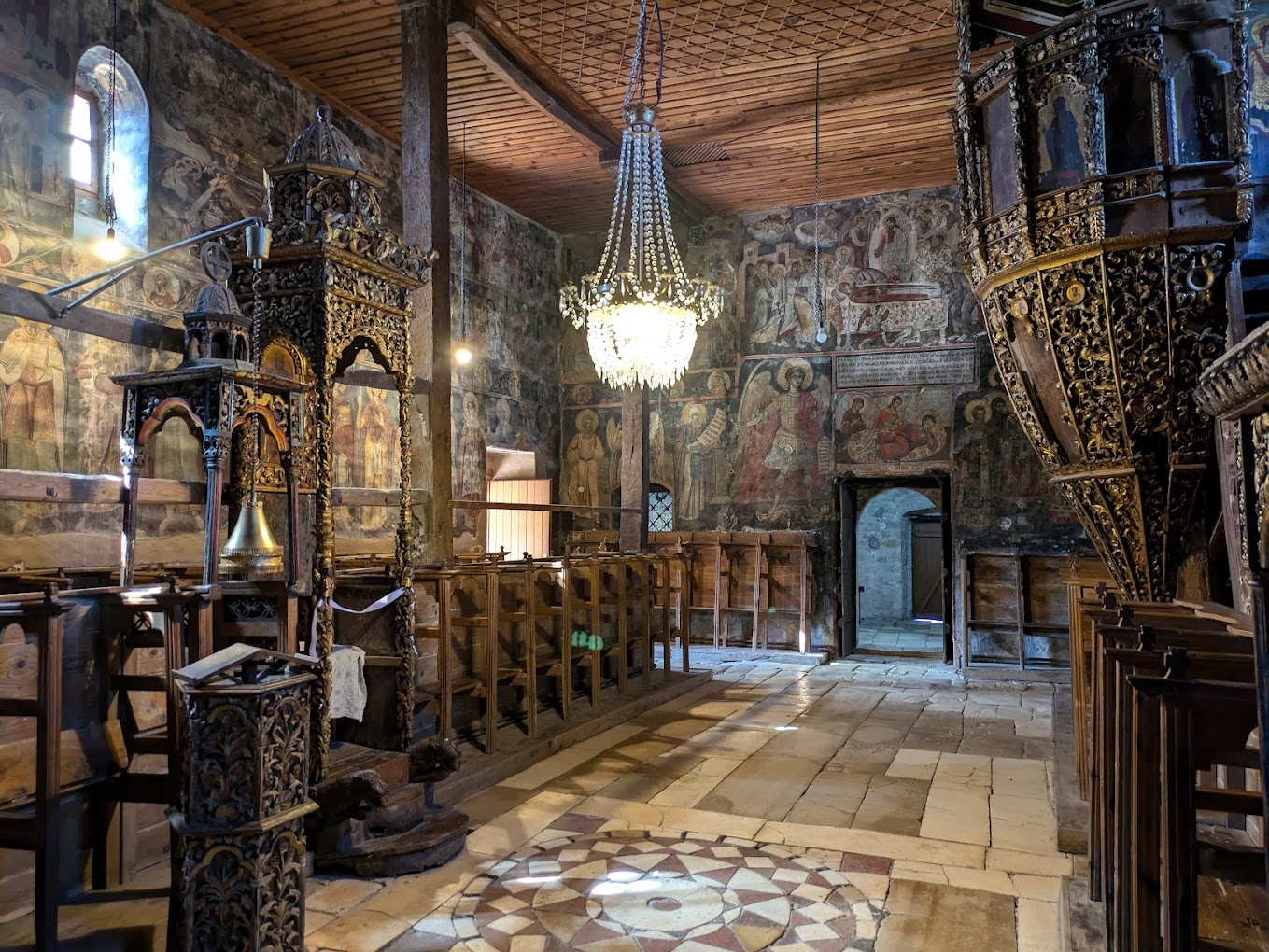
Key Takeaways
- St. Mary’s Monastery is a UNESCO-listed site and a symbol of Albania’s rich religious and cultural heritage.
- Its origins date back to the 13th century, serving as a vital sanctuary during various historical periods.
- The monastery’s Byzantine architecture and vibrant frescoes make it a must-see for history and art enthusiasts.
- It remains an active place of worship and a significant cultural landmark that attracts pilgrims and tourists alike.
- Conservation efforts continue to preserve its art and structure amid environmental and financial challenges.
Table of contents
- Historical Background of St. Mary’s Monastery
- Architectural Marvels and Unique Elements of St. Mary’s Monastery
- Religious and Cultural Significance: An Albanian Landmark
- Practical Tips for Visiting St. Mary’s Monastery
- Preservation and Modern Day Challenges: St. Mary’s Monastery Today
- Conclusion: The Timeless Allure of St. Mary’s Monastery
Nestled amidst the verdant beauty of the exact mountain range, just a short drive from the bustling city of nearest major city, lies St. Mary’s Monastery—a beacon of Albania’s religious and historical legacy. As one of the most revered historical sites in Albania, St. Mary’s Monastery captivates visitors with its rich tapestry of cultural significance and spiritual allure. Its location, easily pinpointed with GPS coordinates, ensures that travelers can embark on a seamless journey to this enchanting site. Known far and wide for its exquisite Byzantine frescoes and profound historical importance, St. Mary’s Monastery offers an unmissable opportunity for those intrigued by Albanian religious sites to explore a pivotal chapter of the nation’s past.
Historical Background of St. Mary’s Monastery
Origins of St. Mary’s Monastery: Foundations of Cultural Heritage in Albania
The story of St. Mary’s Monastery begins in the 13th century, an era of profound transformation and growth for the region. Founded under the auspices of medieval Albanian rulers, the monastery emerged as a vital spiritual center amidst the sweeping landscapes of Albania. Throughout its storied history, the monastery has weathered numerous societal upheavals, including its pivotal role during the Ottoman period when it served as a sanctuary safeguarding Albanian language and culture against foreign influence.
Notably, historical narratives intertwine with the monastery’s legacy, with prominent figures such as shkodra’s revered monks leaving their indelible mark. The monastery’s standing as a bastion of learning and resilience is underscored by its role during Ottoman rule and resistance, rapidly elevating it as a center of cultural preservation. As a testament to its enduring significance, St. Mary’s Monastery not only continues to be a crucial symbol of religious devotion but also as a pivotal vessel for preserving Albania’s cultural heritage amidst shifting historical tides.
Architectural Marvels and Unique Elements of St. Mary’s Monastery
Architectural Style of St. Mary’s Monastery: A Testament to Byzantine Excellence
Dominating its surroundings with an aura of resplendent beauty, the architectural style of St. Mary’s Monastery is a superlative representation of Byzantine architecture. This construction, characterized by intricately patterned stonework and a cross-in-square layout typical of Byzantine design, is a timeless embodiment of religious and aesthetic grandeur.
The exterior welcomes visitors with its grand façade, a harmonious blend of stone and brick, which silently narrates centuries of history. Each architectural facet, from the entrance to the intricately designed dome, reflects the profound artistry and meticulous craftsmanship that has defined Byzantine structures. Unique design elements, such as the octagonal dome supported by elaborate squinches, set St. Mary’s apart from other monasteries scattered across Albania.
Inside, the walls come alive with vibrant frescoes showcasing religious themes, each brushstroke a testament to the enduring artistic heritage of the Byzantine era. These frescoes, differing stylistically from those in similar sites like the Ardenica Monastery, offer a rare glimpse into the rich tapestry of Byzantine art. This array of architectural splendor, both inside and out, firmly establishes St. Mary’s Monastery as a cornerstone of Albania’s religious and cultural identity.
Religious and Cultural Significance: An Albanian Landmark
Religious Significance in Albania: St. Mary’s Monastery as a Cultural Beacon
As a cultural landmark, St. Mary’s Monastery stands as a vibrant symbol of religious significance in Albania, weaving together threads of spiritual tradition and cultural heritage. Its role extends far beyond the confines of its sacred walls, resonating within the heart of the local community. For generations, the monastery has been a focal point of religious fervor, a site where pilgrims gather, drawn to its sanctified aura and the promise of divine intercession.
Each year, the Feast of the Dormition on August 15 transforms the monastery into a hub of religious celebration. This revered event sees multitudes of pilgrims converge, their devotion palpable in the air as rituals unfold against the backdrop of sacred chants and solemn prayers. These festivals, steeped in ancestral tradition, not only reinforce the monastery’s role in religious practice but also fortify its standing as a cultural beacon echoing through Albania’s landscapes.
In every way, St. Mary’s Monastery encapsulates the fusion of spiritual devotion and cultural identity, a testament to the resilient spirit of its custodians who embrace traditions spanning centuries. As an ever-enduring symbol of heritage, the monastery continues to inspire awe and reverence among those who traverse its sacred grounds.
Practical Tips for Visiting St. Mary’s Monastery
Visiting St. Mary’s Monastery: A Guide to Discovering Albanian History
For those planning to immerse themselves in the spiritual and historical aura of St. Mary’s Monastery, practical information ensures a seamless and enlightening visit. Strategically positioned within easy reach of nearest major city, the monastery offers a journey marked by picturesque landscapes that transform the trip into a memorable pilgrimage.
Visitors can approach the site using various transportation options including a bus or taxi, with well-marked paths guiding them towards this sacred destination. Upon arrival, one discovers that the monastery’s gates are generally open from 7:00 AM to 7:00 PM, a structure accommodating pilgrims and tourists alike. While entrance fees are nominal, a small donation is appreciated, contributing to the ongoing preservation of this invaluable cultural site.
To fully embrace the experience, visitors are encouraged to time their visit to coincide with local festivals, where the monastery transforms into a pulsating epicenter of celebratory fervor. Adherence to guidelines such as modest dress and respectful silence within sacred spaces ensures that each moment spent here is imbued with reverence and respect.
Nearby accommodations in the local village provide comfortable lodging options, while local eateries offer delectable Albanian cuisine, rounding off a holistic travel experience. Exploring local Albanian food enriches the journey even further.
Preservation and Modern Day Challenges: St. Mary’s Monastery Today
Preservation Efforts of St. Mary’s Monastery: Addressing Challenges to Cultural Heritage
The enduring beauty of St. Mary’s Monastery is a testament to tireless preservation efforts fueled by the dedication of those determined to protect this historical site. Despite its grandeur, the monastery grapples with challenges that threaten its longevity—from environmental factors like humidity affecting its frescoes, to the absence of sustainable financial support for restoration projects.
Recent restoration activities, supported by the European Union and Albanian government, have focused on stabilizing the structure and conserving its unique frescoes. However, the pathway to ensuring long-term preservation is fraught with obstacles, demanding sustained funding and community involvement.
Amid these challenges, local initiatives and volunteer efforts breathe life into the monastery. Volunteers from the community regularly dedicate their time to maintaining the monastery grounds and surrounding trails, ensuring this emblem of cultural heritage remains accessible and preserved for future generations.
While endeavors around safeguarding St. Mary’s are noteworthy, continuous advocacy and support are indispensable to surmounting the hurdles toward safeguarding the monastery’s cultural and historical legacy, ensuring its story continues to inspire and educate those who venture onto its consecrated land.
Conclusion: The Timeless Allure of St. Mary’s Monastery
Significance of St. Mary’s Monastery: Embrace Albanian Heritage Firsthand
St. Mary’s Monastery serves as a timeless repository of Albania’s resilient spirit and historical grandeur. From illuminating the Byzantine artistry within its hallowed halls to nurturing centuries-old traditions, the monastery stands as a luminous chapter of Albanian heritage, narrating tales that transcend time and borders.
To visit St. Mary’s Monastery is to embark on a journey through history, witnessing firsthand the grandeur of a civilization marked by artistic brilliance and indomitable faith. As the tranquil allure of its enduring spirituality captivates the soul, visitors find themselves part of an unfolding narrative—one urging a deeper understanding of the harmonious coexistence of Albania’s religious and cultural identity.
With such profound connections to the past, preserving the beauty and historical significance of St. Mary’s Monastery through support and visitation ensures its sanctity is maintained and that its story continues to inspire future generations. Supporting ongoing restoration and respecting local traditions will keep this treasured monument alive for centuries to come.


0 Comment